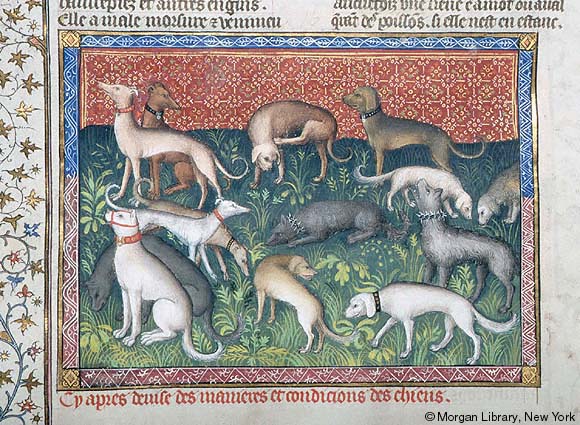 |
| Greyhounds, alaunts, spaniels, mastiffs, and hounds from Livre de la chasse. Paris, France, ca. 1406-1407, MS M.1044 fol. 28v |
Excerpt from Hounds of Muckle Speed by Cynthia Cameron
"Up with ye -- ye big beast."Morag looked down at the large dog peacefully sprawled across the hearth. Gareth was fully absorbed in the gnawing of a bone and didn't show the slightest interest in moving from his favorite spot. "Come now ye great wiry-haired giant, let me to the hearth,"she nudged the hound with her foot as she spoke. "The master will be wanting after his breakfast."Morag managed to wedge herself up to the fire while still attempting to push the big dog away with her foot. "He'll be needing his strength for the hunt." Gareth stopped chewing, looked up at her as if to consider, then returned his interest to the bone, oblivious to Morag's continued grumbling. "Then again, I suppose the real hunter could use a better breakfast too."She fished a kipper from the pan and dangled it from its tail a moment before tossing it backwards across the room. "Aye, that's better."Morag stepped back into the now open space just as Rory MacPherson entered the room wrapped in the muted colors of hunting tartan, quiver slung across his back and bow in hand. Gareth rose and looked at him expectantly. "Mornin', your lairdship."Morag set a plate of kippers and bannocks on the table. "Morning, Morag. A fine day it tis, but even finer for the feast this eve!"A handful of bannocks vanished into the recesses of his plaid. "Come hound of muckle speed,"he tossed the waiting dog a kipper. "Awa for the chase."
Sighthounds
In historic times ownership of rare sighthounds (dogs that hunt by sight rather than scent) was restricted to persons of rank or nobility and hunting dogs were highly valued. While possession of sighthounds today is not restricted, it is enjoyed by a limited number of enthusiasts. Nevertheless, it is becoming more and more frequent to see these dogs in their historic roles at re-creation events. Not only does it add flavor to the event, but such accompaniment can add rich authenticity and accuracy to the persona itself. Hounds of present have survived with their aristocratic character and traits intact and their physical norms only slightly altered from earlier standards. The sighthound's heritage is a colorful picture of medieval life which, due to their exclusive status, brought some breeds near to extinction. Heraldry and tapestries abound with Greyhound-type dogs. One of the panels of the Bayeux Tapestry shows Harold accompanied by a pack of hounds varying in size.
The border of the Bayeux Tapestry contains many breeds of dogs, some of which appear to be Greyhounds, Deerhounds, Wolfhounds and Mastiffs. What follows is a brief history of the nobleman's best friend--dogs prized by kings, princes and nobility for their great speed and endurance and respected for their beauty, grace and dignity.
Sighthounds or gazehounds are some of the most ancient breeds in the world. For thousands of years man relied on their superior hunting skills. Throughout history royal houses from many lands have been linked with sighthounds. While its origins are not positive, the Greyhound is thought to date back over 4000 years to ancient Egypt--a favorite of the pharaohs and predecessor of other sighthound breeds. Explorers from Greece brought Greyhounds from the Middle East. Alexander the Great is said to have kept one. Their popularity grew in Greece and from there the dogs spread across Europe.
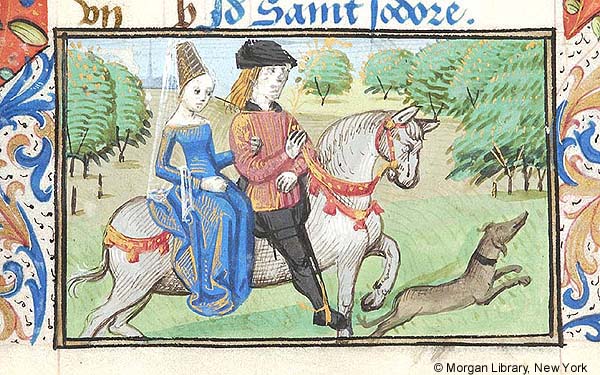 |
| A lord and lady hunting with a greyhound. Pierpont Morgan Library, MS m131. |
Greyhounds
The name Greyhound is thought to be derived from the Saxon word "grei"which means beautiful. During the Dark Ages Greyhounds were saved from near extinction by priests who bred the dogs for noblemen. In 1014 possession of a Greyhound became an exclusive right of the nobility, put into law by King Canute. Well-stocked royal forests were the hunting grounds for these hounds and their masters. Forest laws introduced in 1016 made hunting and poaching forbidden to all people other than those connected with royal estates. Throughout the Renaissance Greyhounds were a favorite of royalty--prized by Queen Elizabeth--and the most common dog used in heraldry. Coursing, the chasing of a live hare, has taken place for at least 2000 years, but it was not until Tudor times that it became popular in England. Coursing was a pastime that turned into a sport and has continued into the present century.
Irish Wolfhounds
The origin of the Irish Wolfhound, the national dog of Ireland, is believed to date back prior to the Christian era. The first reference to the breed was in 391 BC when several Irish Wolfhounds were taken to Rome and, "all Romans viewed them in wonder."Ancestors of the present day breed were used by Irish kings and nobles for pursuit of elk, wolf and wild boar. In his autobiography, Saint Patrick tells how he looked after his master's Wolfhounds until he was able to escape slavery by jumping onto a ship transporting Wolfhounds to wealthy buyers in France.
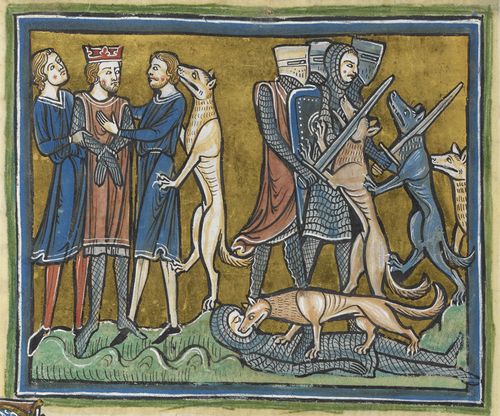 |
| Detail of a miniature of King Garamantes, being rescued by his dogs; from the Rochester Bestiary, England (Rochester?), c. 1230, Royal MS 12 F. xiii, f. 30v. |
With the speed inherited from their Greyhound ancestors, together with larger size and greater strength which was developed from living in a harsher climate, the Irish Wolfhound was able to overpower its prey or to hold it at bay until the hunter arrived to seal its fate. Wolfhounds primarily defeated their game by breaking its spine with their jaws. The Irish Wolfhound is elegant, gentle and trusting, but when the occasion arises it can be intimidating and swift--qualities echoed in an ancient Irish king's motto, "gentle when stroked, fierce when provoked."So prized were these dogs that their ownership was limited to nobility. The thirteenth century monument at Beddglert Priory in Wales is a good example of how highly regarded and valued a good hound was. It is believed to have been erected by Welsh prince, Llewellen Fawr, in tribute to his beloved and favorite wolfhound, Faithful Gelert, a gift given to him by his father-in-law, King John.
The fourteenth through sixteenth centuries English monarchs requested these dogs, referred to as "large greyhounds, rough greyhounds or wolfdogs"and described as, "like powerful shaggy greyhounds, but a good deal larger" be sent from Ireland to England. In 1658, Oliver Cromwell ordered a ban on the export of these hounds from the British Isles, as their numbers were on the decline and they were needed in England to keep the wolf population under control. But, with the disappearance of the wolf from the British Isles in the eighteenth century, the breed suffered a drastic decline and became almost extinct.
In 1862, Captain George Graham, a Scotsman, began re-establishing the Wolfhound by crossing a few survivors of the breed with the Scottish Deerhound and other breeds, including the Great Dane and probably the Borzoi. Later, in 1902, he was asked on behalf of the Irish Wolfhound Club, founded after he and a few other enthusiasts successfully rescued the breed, to choose an Irish Wolfhound which could be presented to the Irish Guards as their mascot. Today an Irish Wolfhound is still the mascot of the Irish Guards and is seen on parade with the regiment every year on Saint Patrick's Day.
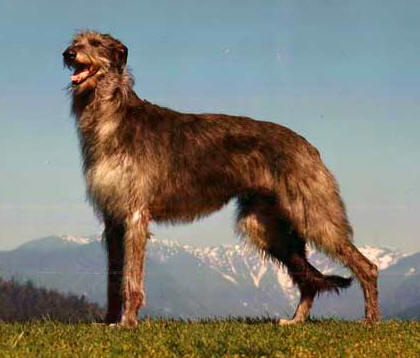 |
| Fernhill's Kendra, champion Scottish Deerhound |
Scottish Deerhounds
Gentle and dignified, the Scottish Deerhound still portrays the power, speed and strength of its ancestors. Affectionate, and loyal, and always eager to please, the Royal Dog of Scotland, Highland Greyhound, Rough Greyhound and Scottish Deerhound are the names by which this aristocratic and ancient hound were known in the past. Like many older breeds, it's history is not easy to define. There is no doubt the breed resembles the Greyhound, whose ancestors are thought to have been brought to Britain by Phoenician traders in the second century B.C. Whether or not dogs had long or short coats at that time is not known. If similar to other breeds who were taken to colder harsher climates, they would, out of necessity, have developed thick coats. A surviving manuscript from the sixteenth century notes, "some are of a greater sorte, some of a lesser; some are smoothe skynned and some curled, the bigger therefore are appointed to hunt bigger beasties."Most certainly the description is of Greyhounds and the Wolfhounds and Deerhounds evolved from them. At one time Deerhounds were thought to be identical with the "Irish Wolfdog"and, in the course of centuries, bred to a type better suited to hunt deer or to a descendant of the hounds of the Picts.
From the earliest times sighthounds were used for deer coursing. The Deerhound is quiet and dignified, keen and alert. While not aggressive, it has great persistence and indomitable courage when necessary, all desirable traits; but, most valued was the combination of speed and strength necessary to cope with Scottish deer weighing up to 250 pounds. Hounds were hunted singly or in pairs.
Owing to their outstanding ability, Deerhounds had few equals and were highly esteemed. This meant that only Highland Chieftains and the aristocracy who owned large deer-forests kept these hounds--anyone in a lesser position was not permitted to do so. Deerhounds were so highly coveted, that a noble lord condemned to death might purchase his reprieve with a pair.
 |
| Harold hunting with deerhounds and wolfhounds in the 11th century, Bayeaux tapestry. The largest are depicted as nearly as tall as the stag. |
As the larger beasts of the chase became extinct or rare in England and southern Scotland, the smaller, more delicate Greyhound took the place of the larger Deerhound coursing rabbit and smaller game. In the highlands of Scotland, the stag remained numerous in the wild and became the last stronghold of the Deerhound. Highland Chieftains assumed exclusive ownership which was enforced to such an extent that it was rare to find a good specimen south of the River Forth. After the Battle of Culloden in 1746, the prejudice of King George II's Hanoverian government sought to demolish the clan system (including clans loyal to the crown) by diminishing the hierarchy of the clan and inserting their own rule. With the collapse of the clan system and the invention of the sporting rifle came the decline of the breed--so much so that a visitor to Gordon Castle in 1769 had good reason to be excited when he said he saw, "a true Scottish Greyhound is of large size, strong, deep chested, and covered with a very long rough hair."
In 1825, Duncan and Archibald McNeil undertook the restoration of the breed. Along with Lord Colonsay, the Menzies family and other Highland owners, the Deerhounds, although somewhat smaller in size, were saved from extinction and regained their former perfection as "Royal Dog of Scotland."Centuries of acting as guard and hunting companion to its master has given the Deerhound, and its Irish cousin the Wolfhound, a desire for human companionship, eagerness to please, excellent temperament and a gentle dignity. Queen Victoria, Prince Albert and Sir Walter Scott were all devoted owners of Deerhounds, demonstrating that the breed was gaining in popularity as the century drew to a close. Sir Walter Scott described them as, "The most perfect creature of Heaven."
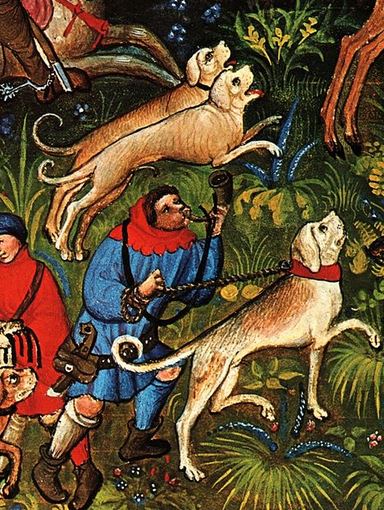 |
|
Mastiffs hunting a stag from |
Mastiffs
The Mastiff is not a sighthound, but carries an impressive history romanticized throughout the Middle Ages and Renaissance. It is one of the few breeds, probably including the Greyhound, that can be traced to a time when nations from the East dominated the world. They are large, powerful dogs which possess the qualities of courage and grandeur yet can be gentle and affectionate. The term "mastiff"describes a group of giant varieties of dog rather than a single breed. Supposedly originating in Asia, the Tibetan Mastiff is thought to be the most direct descendant of the prototype. Next would be today's Old English Mastiff disputed by some to be the main root from which come the other Mastiff groups. Surviving art and literature record how active, massive dogs lived centuries before the Christian era. Drawings on Egyptian monuments of typical Mastiffs date to about 3000 BCE. In Chinese literature the earliest reference is about 1121 BCE. Many nations from the Middle East and the Orient--Assyria, Babylon, Egypt, Greece, Rome, Tibet and China--employed Mastiff type dogs in significant numbers for their fighting and hunting qualities. Large numbers of these dogs were kept for hunting various types of big game, mainly wild boar and lions. Besides being used by armies to protect their encampments and their livestock against predators, some armies, especially the Greeks and Romans, trained the dogs for battle and for defense purposes. They were also used for fighting in the Roman arenas against gladiators and defenseless prisoners. Guarding comes naturally to the Mastiff. In the Orient, Mastiffs guarded palaces, monasteries, temples and any property of value.
Records indicate that Mastiffs, or dogs closely resembling the breed, were already established in Britain when the Roman Legions invaded in 43ad. Although they may have been indigenous, it seems more likely the dogs were brought to Britain either by the Celts or by the Phoenicians, known traders of livestock.
In the British Isles, due to their size and strength, Mastiff activities were the same as they had been for centuries. While the Mastiff was always considered a fighting dog, it was as a tiedog (tied by day, loose at night) that it earned its keep. During Anglo-Saxon times the keeping of Mastiffs was compulsory for the peasant. For each two villeins (villagers) there was to be kept at least one Mastiff. By this means wolves and game animals were kept under control and the manor profitable.
That the Mastiff was so numerous in England is evidenced in the English language itself. The ancient word in Anglo-Saxon and kindred languages for a canine is similar to "hound."The modern word "dog"means a mastiff-type dog in all languages except English. In 1066, when the Normans conquered the Anglo-Saxons, Norman-French became the official language and "dogues"(or Mastiffs) were so plentiful that people came to call all canines by that name. The Mastiff was also known by another name, the Alaunt, an Italian-French word, deriving from the Alani or people of Albania, where the dogs were highly regarded in ancient times. In the "Knight's Tale" Chaucer describes the Mastiff's majesty of size and power:
"About his char ther wenten white Alaunts
Twenty and mo,
as gret as any stere
To hunten at the leon ore the dere."
 Forest laws introduced to preserve the monarch's deer in 1016 were not entirely successful. Poachers were punished severely. During the reign of King John, "all Mastiffs found poaching in the Crown Forests" were ordered to be destroyed. Mastiffs were also used in the sport of bear and bull baiting, popular in the Roman arenas, and introduced to Britain with the arrival of the Legions. This pursuit was very popular in the Tudor dynasty and continued in one form or another until finally banned in 1835 by Queen Victoria. Mastiffs were employed within the English armies through the times of Henry VIII. Due to social changes and improved weapons of the seventeenth century, the fine qualities of these dogs were no longer required and there was a gradual decline. By 1946 the breed had been reduced to less than ten that were safeguarded in the United States after the outbreak of World War II. Luckily, since then the breed has been reestablished.
Forest laws introduced to preserve the monarch's deer in 1016 were not entirely successful. Poachers were punished severely. During the reign of King John, "all Mastiffs found poaching in the Crown Forests" were ordered to be destroyed. Mastiffs were also used in the sport of bear and bull baiting, popular in the Roman arenas, and introduced to Britain with the arrival of the Legions. This pursuit was very popular in the Tudor dynasty and continued in one form or another until finally banned in 1835 by Queen Victoria. Mastiffs were employed within the English armies through the times of Henry VIII. Due to social changes and improved weapons of the seventeenth century, the fine qualities of these dogs were no longer required and there was a gradual decline. By 1946 the breed had been reduced to less than ten that were safeguarded in the United States after the outbreak of World War II. Luckily, since then the breed has been reestablished.
Adopting a pet
Today these rare dogs are being carefully bred to preserve their noble heritage and the best traits of the breed and seen most frequently in the show ring, but also on the hearth as loyal companions; living gems of history to be treasured. The good news is ownership is now open to those of us "lower than the rank of earl"and information is readily available on the different breeds. If you think one of these stately hounds is for you make sure you, look at all the angles before making your decision. First, know something about the breed before you bring it home. Determine if owning a hound is in the best interests of the dog. Do you have the time, space and finances to keep an animal? Dogs require exercise, space and affection to keep them physically and mentally happy. Health care is essential and can be costly. Puppies grow up to be dogs and live for many years. Training requires diligence and patience. While dogs are a huge responsibility they can payoff in a rewarding friendship and allow you to bring a living piece of history to your daily life.
About the Author
Cynthia Cameron is a freelance writer and dog breeder residing in Tucson.
Resources
Greyhound Pets of America
800-366-1472
Arizona Greyhound Rescue
520-647-7572
For quality breeders,
call your local kennel club
American Kennel Club
Further Reading
Medieval Hunting
http://en.wikipedia.org/wiki/Medieval_hunting
Nothin' but a hounddog
http://britishlibrary.typepad.co.uk/digitisedmanuscripts/2013/02/nothin-but-a-hound-dog.html
